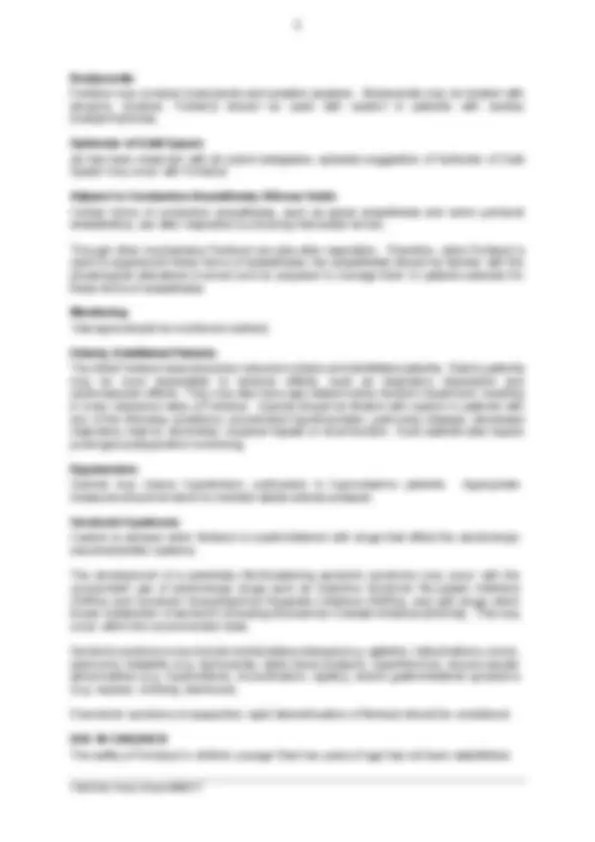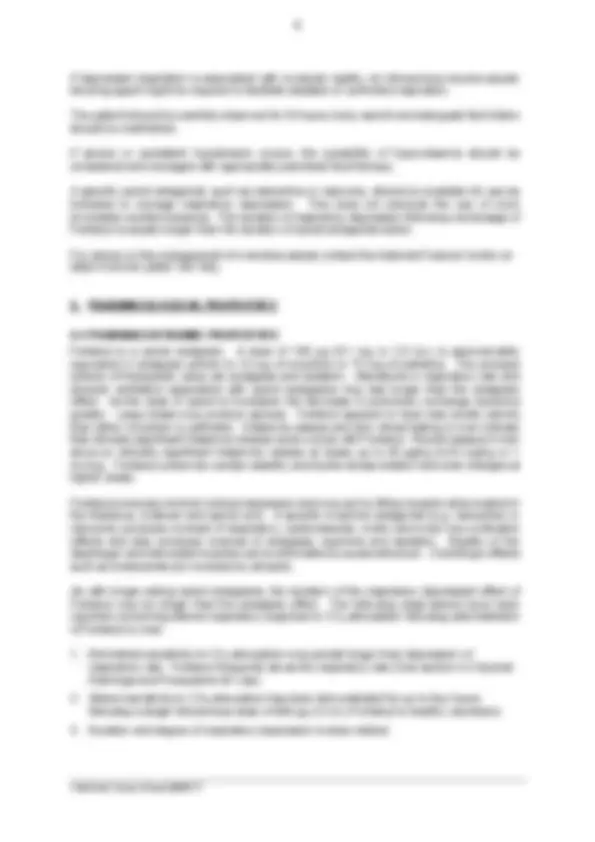








Study with the several resources on Docsity

Earn points by helping other students or get them with a premium plan


Prepare for your exams
Study with the several resources on Docsity

Earn points to download
Earn points by helping other students or get them with a premium plan
Community
Ask the community for help and clear up your study doubts
Discover the best universities in your country according to Docsity users
Free resources
Download our free guides on studying techniques, anxiety management strategies, and thesis advice from Docsity tutors
Information on the dosage and method of administration of Fentanyl, a potent opioid analgesic. It covers precautions for head injuries, concomitant MAO inhibitors, myasthenia gravis, and the use of other CNS depressants. It also discusses the risks of respiratory depression and sedation, muscle rigidity, and impaired liver and kidney function. The document emphasizes the importance of individualized dosing and cautions against concomitant use of certain medications.
Typology: Summaries
1 / 11

This page cannot be seen from the preview
Don't miss anything!







Fentanyl citrate 50 μg/mL, solution for injection
Each 2ml ampoule contains 100 micrograms of Fentanyl as Fentanyl citrate. Each 10ml ampoule contains 500 micrograms of Fentanyl as Fentanyl citrate.
For the full list of excipients, see section 6.
Injection: a clear, colourless, particle-free solution, pH 4.0-7.5, and containing fentanyl 50μg/mL (as citrate).
Fentanyl is chemically identified as N-(1-phenethyl-4-piperidyl) propionanilide citrate, MW 528.61.
Short duration analgesia during pre-medication, induction and maintenance of anaesthesia, and in the immediate post-operative period.
Opioid analgesic supplement to general and regional anaesthesia.
Combination with a neuroleptic as an anaesthetic pre-medication for the induction of anaesthesia, and as an adjunct in the maintenance of general and regional anaesthesia.
Dosage should be individualised according to age, bodyweight, physical status, underlying pathological condition, use of other medicines, type of anaesthesia to be used and the surgical procedure involved (see also section 4.4 Special Warnings and Precautions for Use). FENTANYL I NJECTION contains no antimicrobial agent. It should be used only once and any residue discarded.
ADULTS
Premedication
(To be appropriately modified in the elderly, debilitated and those who receive other depressant medicines): 50 to 100 μg (1 to 2 mL) may be administered intramuscularly 30 to 60 minutes prior to surgery.
Adjunct to general anaesthesia
Induction: 50 to 100 μg (1 to 2 mL) IV initially, repeat at two to three minute intervals until desired effect is achieved. A reduced dose of 25 to 50 μg (0.5 to 1 mL) is recommended in elderly and poor risk patients.
Maintenance
25 to 50 μg (0.5 to 1 mL) IV or IM when movement and/or changes in vital signs indicate surgical stress or lightening of analgesia.
Adjunct to regional anaesthesia
50 to 100 μg (1 to 2 mL) may be administered IM or slowly IV when additional analgesia is required.
Post-operatively (recovery room)
50 to 100 μg (1 to 2 mL) may be administered IM for the control of pain, tachypnoea and emergence delirium. The dose may be repeated in one or two hours as needed.
CHILDREN
For induction and maintenance in children 2 to 12 years of age, a reduced dose of 20 to 30 μg (0.4 to 0.6 mL) per 10 kg is recommended.
IMPAIRED RENAL FUNCTION
Fentanyl should be used with caution.
IMPAIRED HEPATIC FUNCTION
Fentanyl should be used with caution.
INCOMPATIBILITIES:
Fentanyl is incompatible with thiopentone sodium and methohexitone sodium.
**1. Known hypersensitivity or intolerance to fentanyl, other opioid analgesics, or to any of the excipients.
(See also section 4.4 Special Warnings and Precautions for Use).
3. Head injuries and increased intracranial pressure
As for any opioid analgesic, Fentanyl should not be used in patients susceptible to respiratory depression, such as comatose patients who may have head injuries or a brain tumour. (See also section 4.4 Special Warnings and Precautions for Use). Fentanyl may obscure the clinical course of patients with head injury.
4. Concomitant MAO inhibitors
Severe and unpredictable potentiation by MAO inhibitors has been reported with opioid analgesics and the use of Fentanyl in patients who have received MAO inhibitors within 14 days is not recommended. (See section 4.5 Interactions).
Total Opioid dose
As with other potent opioids, the respiratory depressant effect of Fentanyl persists longer than the measured analgesic effect. The total dose of all opioid analgesics should be considered before additional opioid analgesics are given during recovery from anaesthesia. It is recommended that post-operative opioids, when required, should be used initially in reduced doses, as low as 1/4 to 1/3 of those usually recommended.
Muscle Rigidity
Fentanyl may cause muscle rigidity, particularly involving the muscles of respiration. This effect is related to the dose and speed of injection and may be reduced by slow intravenous injection. If this effect occurs, it may be managed by the use of assisted or controlled respiration and, if necessary, by administration of a neuromuscular blocking agent compatible with the patient's condition.
Nonepileptic myoclonic movements can occur.
Drug Dependence
Fentanyl can produce drug dependence of the morphine type and therefore has the potential for being abused.
Patients on chronic opioid therapy or with a history of opioid abuse may require higher doses to achieve an adequate therapeutic effect.
Respiratory Depression
Depression of respiration is the most marked and dangerous side effect of Fentanyl. In the post-operative period, patients may exhibit delayed depression of respiration. Patients should be monitored for this possibility and appropriate countermeasures taken as necessary. (See Impaired Respiration below).
Impaired Respiration
Fentanyl should be used with caution in patients with severe impairment of pulmonary function because of the possibility of respiratory depression (e.g. chronic obstructive pulmonary disease, patients with decreased respiratory reserve, or any patient with potentially compromised respiration).
In such patients, opioids may further decrease respiratory drive and increase airway resistance. During anaesthesia, this can be managed by assisted or controlled respiration.
Use of Opioid Antagonists for Respiratory Depression
Respiratory depression caused by opioid analgesics can be reversed by opioid antagonists.
However, appropriate surveillance should be maintained because the duration of respiratory depression of doses of Fentanyl employed during anaesthesia is usually longer than the duration of opioid antagonist action. Consult individual product information (nalorphine or naloxone) before employing opioid antagonists.
Impaired Liver and Kidney Function
Fentanyl should be administered with caution to patients with liver and kidney dysfunction because of the importance of these organs in the metabolism and excretion of medicines.
Bradycardia
Fentanyl may produce bradycardia and possibly asystole. Bradycardia may be treated with atropine; however, Fentanyl should be used with caution in patients with cardiac bradyarrhythmias.
Sphincter of Oddi Spasm
As has been observed with all opioid analgesics, episodes suggestive of Sphincter of Oddi Spasm may occur with Fentanyl.
Adjunct to Conduction Anaesthesia; Nitrous Oxide
Certain forms of conduction anaesthesia, such as spinal anaesthesia and some peridural anaesthetics, can alter respiration by blocking intercostal nerves.
Through other mechanisms Fentanyl can also alter respiration. Therefore, when Fentanyl is used to supplement these forms of anaesthesia, the anaesthetist should be familiar with the physiological alterations involved and be prepared to manage them in patients selected for these forms of anaesthesia.
Monitoring
Vital signs should be monitored routinely.
Elderly, Debilitated Patients
The initial Fentanyl dose should be reduced in elderly and debilitated patients. Elderly patients may be more susceptible to adverse effects, such as respiratory depression and cardiovascular effects. They may also have age related kidney function impairment, resulting in lower clearance rates of Fentanyl. Opioids should be titrated with caution in patients with any of the following conditions: uncontrolled hypothyroidism, pulmonary disease, decreased respiratory reserve, alcoholism, impaired hepatic or renal function. Such patients also require prolonged postoperative monitoring.
Hypotension
Opioids may induce hypotension, particularly in hypovolaemic patients. Appropriate measures should be taken to maintain stable arterial pressure.
Serotonin Syndrome
Caution is advised when fentanyl is coadministered with drugs that affect the serotonergic neurotransmitter systems.
The development of a potentially life-threatening serotonin syndrome may occur with the concomitant use of serotonergic drugs such as Selective Serotonin Re-uptake Inhibitors (SSRIs) and Serotonin Norepinephrine Reuptake Inhibitors (SNRIs), and with drugs which impair metabolism of serotonin (including Monoamine Oxidase Inhibitors [MAOIs]). This may occur within the recommended dose.
Serotonin syndrome may include mental-status changes (e.g. agitation, hallucinations, coma), autonomic instability (e.g. tachycardia, labile blood pressure, hyperthermia), neuromuscular abnormalities (e.g. hyperreflexia, incoordination, rigidity), and/or gastrointestinal symptoms (e.g. nausea, vomiting, diarrhoea).
If serotonin syndrome is suspected, rapid discontinuation of fentanyl should be considered.
USE IN CHILDREN
The safety of Fentanyl in children younger than two years of age has not been established.
The combination of calcium channel blockers and beta-adrenergic blockers during Fentanyl anaesthesia should be used with caution since severe hypotension has been reported to occur.
SEROTONIN SYNDROME
Opioids can interact with antidepressants and migraine medicines to cause a serious central nervous system reaction called serotonin syndrome in which high levels of the chemical serotonin build up in the brain and cause toxicity.
Coadministration of sibutramine hydrochloride with Fentanyl may increase the risk of serotonin syndrome (hypertension, hypothermia, myoclonus and mental status changes).
Category C
Opioid analgesics may cause respiratory depression in the newborn infant. These products should only be used during labour after weighing the needs of the mother against the risk to the foetus. If Fentanyl is nevertheless administered, an antidote should always be at hand for the child. The safe use of Fentanyl has not been established with respect to possible adverse effects upon foetal development. Therefore it should be used in women of childbearing potential only when in the judgement of the physician the potential benefits outweigh the possible hazards.
Withdrawal symptoms in newborn infants have been reported with prolonged use of opioids.
BREAST-FEEDING
Fentanyl may enter the maternal milk. Therefore, breastfeeding is not recommended for 24 hours following the administration of the medicine.
Patients should only drive or operate a machine if sufficient time has elapsed after the administration of fentanyl.
4.8 UNDESIRABLE EFFECTS
Respiratory depression, apnoea, muscular rigidity, myoclonic movements, bradycardia, tachycardia, vein pain and allergic dermatitis. If these remain untreated, respiratory arrest, circulatory depression, or cardiac arrest could occur.
Respiratory depression is more likely to occur with intravenous administration if a dose is given too rapidly; it rarely occurs with intramuscular administration. If respiratory depression occurs during anaesthesia, assisted or controlled respiration will provide adequate ventilation without reversing analgesia. Respiratory depression can be immediately reversed by opioid antagonists (e.g. nalorphine or naloxone) which, it should be noted, will also reverse analgesia. Secondary rebound respiratory depression has been observed after the operation in rare instances.
Muscular rigidity may be associated with reduced pulmonary compliance and/or apnoea, laryngospasm or bronchospasm. Prompt reversal of this effect can be achieved with the intravenous administration of an appropriate single dose of a muscle relaxant such as suxamethonium. Assisted or controlled respiration is required to provide ventilation after the use of muscle relaxants.
Bradycardia and other cholinergic effects may occur and can be controlled with the appropriate dose of atropine. The inclusion of atropine or other anticholinergic agents in the pre-anaesthetic regimen tends to reduce the occurrence of such effects.
Hypotension, hypertension, dizziness, blurred vision, miosis, nausea, emesis, constipation, laryngospasm, diaphoresis, itching, euphoria, seizures, spasm of the sphincter of Oddi, anaphylaxis, headache, loss of consciousness, myoclonus, phlebitis, hyperventilation, hiccups, cough, hypothermia, airway complications of anaesthesia, agitation postoperative. Motor stimulation and bronchospasm may occur with high doses of Fentanyl. Less frequently, cardiac arrhythmias, postoperative mental depression, paradoxical CNS excitation or delirium may occur.
FENTANYL/NEUROLEPTIC COMBINATION
When a neuroleptic such as droperidol is used with Fentanyl, the following adverse reactions can occur: chills and/or shivering, restlessness and postoperative hallucinatory episodes sometimes associated with transient periods of mental depression; extrapyramidal symptoms (dystonia, akathisia and oculogyric crisis) have been observed up to 24 hours postoperatively. When they occur, extrapyramidal symptoms can usually be controlled with antiparkinson agents.
Postoperative drowsiness is also frequently reported following the use of droperidol.
Elevated blood pressure with or without pre-existing hypertension, has been reported following administration of fentanyl combined with droperidol. This might be due to unexplained alterations in sympathetic activity following large doses; however, it is also frequently attributed to anaesthetic and surgical stimulation during light anaesthesia.
Reporting suspected adverse reactions after authorisation of the medicine is important. It allows continued monitoring of the benefit/risk balance of the medicine. Healthcare professionals are asked to report any suspected adverse reactions https://nzphvc.otago.ac.nz/reporting/.
Narcosis (which may be preceded by marked skeletal muscle rigidity), cardiorespiratory depression accompanied by cyanosis, followed by a fall in body temperature, circulatory collapse, coma and possibly death.
TREATMENT
In the presence of hypoventilation or apnoea, oxygen should be administered and respiration assisted or controlled as necessary. A patent airway must be maintained.
The pharmacokinetics of Fentanyl can be described by a three-compartment model, with a distribution time of 1.7 minutes, redistribution of 13 minutes and a terminal elimination half- life of 219 minutes. The volume of distribution for Fentanyl is 4 L/kg.
The onset of action is almost immediate when the drug is given intravenously; however, the maximal analgesic and respiratory depressant effect may not be noted for several minutes. The usual duration of action of the analgesic effect is 30 to 60 minutes after a single IV dose of up to 100 μg. Following intramuscular administration, the onset of action is from seven to eight minutes and the duration of action is one to two hours.
Fentanyl plasma protein binding capacity increases with increasing ionisation of the drug.
Alterations in pH may affect its distribution between plasma and the central nervous system. It accumulates in skeletal muscle and fat, and is released slowly into the blood.
Fentanyl is primarily transformed in the liver and demonstrates a high first pass clearance with approximately 75% of an intravenous dose excreted in urine, primarily as metabolites with less than 10% representing the unchanged drug. Approximately 9% of the dose is recovered in the faeces, primarily as metabolites.
6.2 INCOMPATIBILITIES
Not applicable
6.3 SHELF LIFE
18 months
2mL : Store below 25°C 10 mL: Store below 30°C
Polyamp Duofit 50 μg/mL, 10 x 2 mL and 10 x 10 mL.
FENTANYL I NJECTION contains no antimicrobial agent. It should be used once only and any residue discarded. Return unused and expired medicines to your local pharmacy for disposal.
Controlled Drug B3.
Juno Pharmaceuticals NZ Limited P O Box 76261 Manukau City Auckland 2241
17 October 1991
10. DATE OF REVISION OF THE TEXT
1 May 2019
API 290816 RDS V4 – 10 April 2017
SUMMARY TABLE OF CHANGES
Section changed Summary of new information
8 Update sponsor details to Juno.